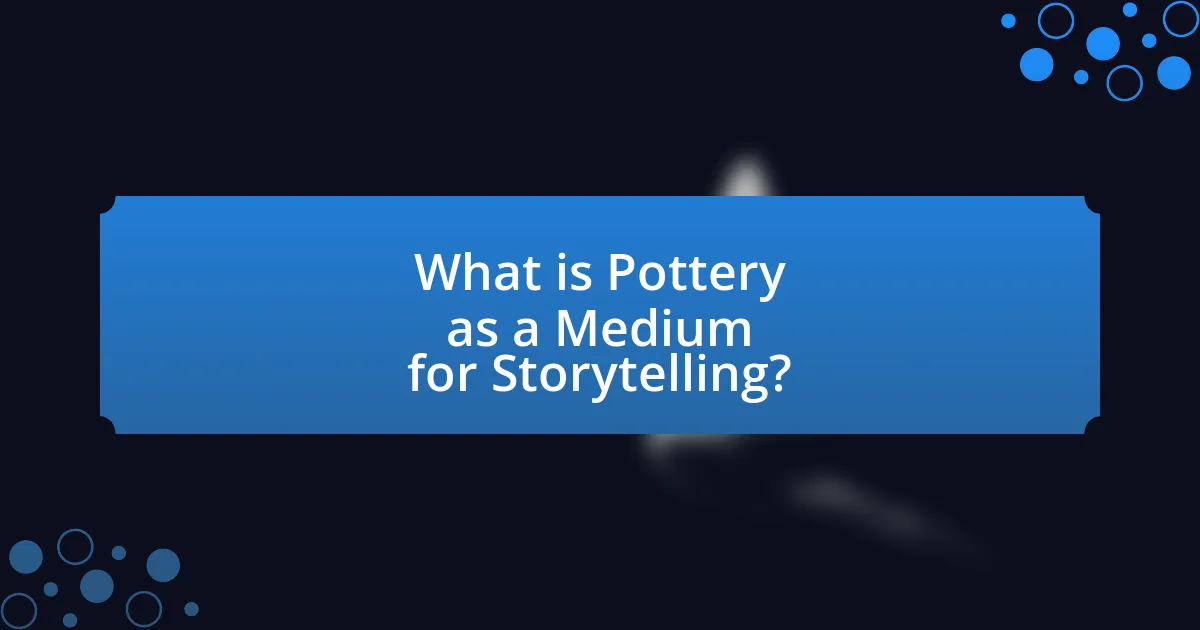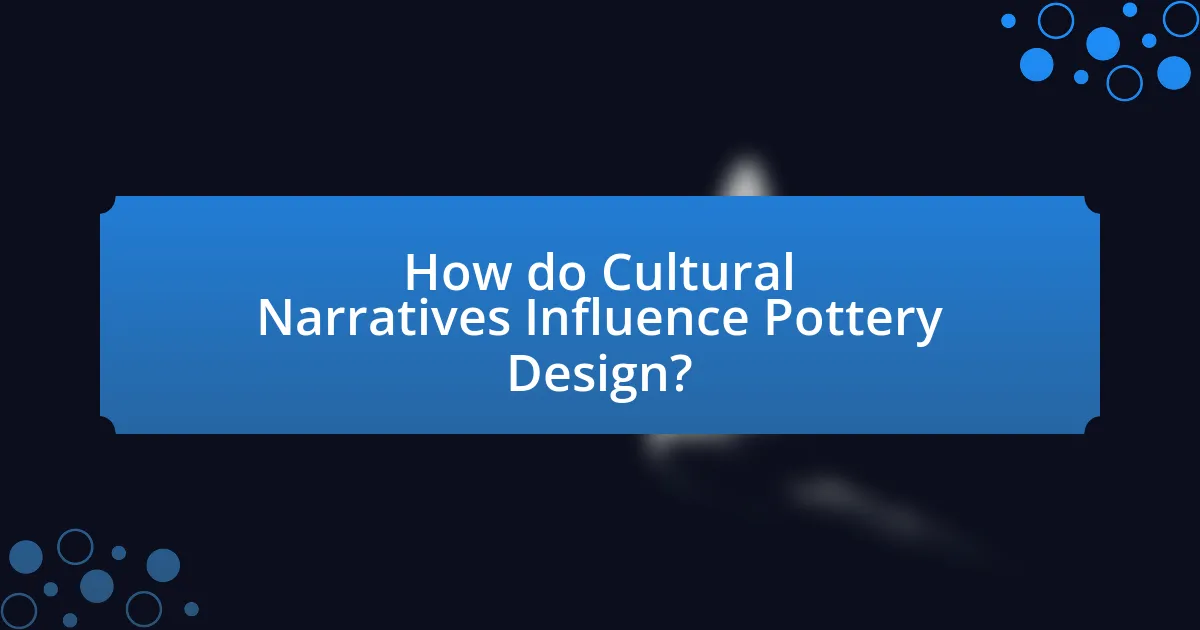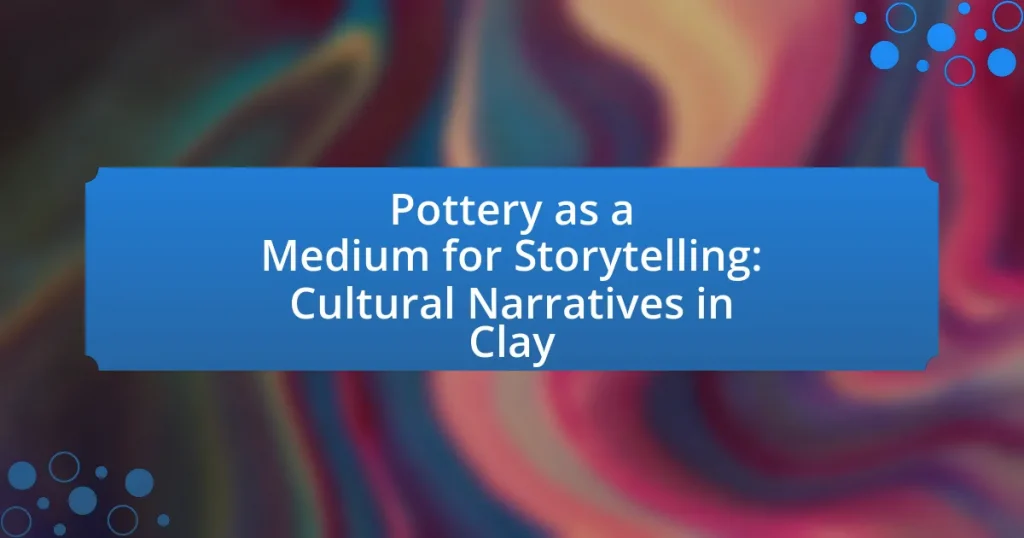Pottery serves as a significant medium for storytelling, allowing artists to convey cultural narratives, historical events, and personal experiences through ceramic art. This article explores the historical use of pottery in various ancient cultures, such as the Greeks and Native Americans, highlighting how decorative motifs and symbols reflect societal values and beliefs. It examines the unique properties of clay that enhance its storytelling potential, the themes commonly explored in pottery narratives, and the influence of cultural, environmental, and socio-political factors on pottery design. Additionally, modern techniques and best practices for creating narrative pottery are discussed, emphasizing the integration of technology and community engagement in contemporary artistic expression.

What is Pottery as a Medium for Storytelling?
Pottery as a medium for storytelling is the use of ceramic art to convey narratives, cultural beliefs, and historical events. This form of expression allows artists to embed symbols, motifs, and imagery into their work, which can communicate complex stories and cultural identities. For instance, ancient civilizations, such as the Greeks and Native Americans, utilized pottery to depict myths, daily life, and spiritual beliefs, effectively preserving their narratives through visual means. The intricate designs and forms of pottery serve not only as functional objects but also as vessels of cultural memory, enabling future generations to connect with their heritage.
How has pottery been used historically to convey stories?
Pottery has historically been used to convey stories through decorative motifs and inscriptions that reflect cultural narratives and historical events. For instance, ancient Greek pottery often depicted scenes from mythology and daily life, serving as a visual storytelling medium that communicated societal values and beliefs. Additionally, Native American pottery frequently features symbols and designs that represent tribal history, spiritual beliefs, and natural elements, effectively narrating the community’s identity and traditions. These artistic expressions in clay not only served functional purposes but also acted as a canvas for storytelling, preserving and transmitting cultural heritage across generations.
What are some ancient cultures known for storytelling through pottery?
Ancient cultures known for storytelling through pottery include the Minoans, the Greeks, and the Native American Pueblo peoples. The Minoans, active on the island of Crete around 2000-1450 BCE, created intricate pottery featuring scenes of mythology and daily life, which served as a narrative medium. The Greeks, particularly during the Archaic and Classical periods, utilized pottery to depict mythological tales and historical events, with black-figure and red-figure techniques illustrating stories of gods and heroes. Similarly, the Pueblo peoples of the American Southwest, known for their distinctive pottery styles, often incorporated symbols and designs that conveyed cultural narratives and spiritual beliefs, reflecting their connection to the land and community.
How do different pottery styles reflect cultural narratives?
Different pottery styles reflect cultural narratives by embodying the values, beliefs, and historical experiences of the societies that create them. For instance, Native American pottery often features intricate designs that symbolize spiritual beliefs and connection to nature, while ancient Greek pottery frequently depicts mythological scenes that convey societal ideals and historical events. These stylistic choices serve as visual storytelling, allowing viewers to understand the cultural context and significance behind each piece. The use of specific motifs, colors, and techniques in pottery can also indicate regional identities and social hierarchies, further illustrating how pottery serves as a medium for cultural expression and narrative.
Why is clay considered a powerful medium for storytelling?
Clay is considered a powerful medium for storytelling because it allows for tactile expression and the creation of three-dimensional narratives that engage viewers on multiple sensory levels. This medium has been used historically across cultures to convey stories, beliefs, and traditions, as evidenced by ancient pottery that features intricate designs and symbols representing cultural narratives. For instance, Native American pottery often incorporates motifs that reflect their mythology and daily life, effectively communicating their stories through visual art. The malleability of clay enables artists to shape and mold their narratives, making it a versatile tool for storytelling that transcends language barriers and connects communities through shared cultural heritage.
What unique properties of clay enhance its storytelling potential?
The unique properties of clay that enhance its storytelling potential include its malleability, texture, and ability to retain impressions. Malleability allows artists to shape clay into diverse forms, enabling the representation of various narratives and cultural symbols. The texture of clay can evoke different sensory experiences, adding depth to the story being told. Additionally, clay’s capacity to retain impressions means that it can capture intricate details, such as carvings or fingerprints, which can convey personal or communal histories. These properties collectively facilitate the creation of pottery that serves as a medium for storytelling, reflecting cultural narratives and individual expressions.
How does the tactile nature of pottery engage audiences?
The tactile nature of pottery engages audiences by inviting them to physically interact with the artwork, enhancing their sensory experience. This hands-on engagement allows individuals to feel the texture, weight, and temperature of the clay, which fosters a deeper emotional connection to the piece. Research indicates that tactile experiences can stimulate brain activity related to memory and emotion, making the interaction more memorable and impactful. For instance, studies have shown that touching objects can evoke personal stories and cultural narratives, reinforcing the storytelling aspect of pottery as a medium.
What themes are commonly explored in pottery storytelling?
Common themes explored in pottery storytelling include cultural identity, mythology, and social commentary. Cultural identity is often depicted through traditional designs and symbols that reflect the heritage of a community. Mythology is represented through narratives illustrated on pottery, showcasing deities, creation stories, and folklore that are significant to a culture. Social commentary is conveyed through pottery that addresses contemporary issues, such as environmental concerns or social justice, allowing artists to express their perspectives and provoke thought. These themes are validated by numerous studies, including those that analyze indigenous pottery, which often serves as a historical record of societal values and beliefs.
How do personal and communal narratives manifest in pottery?
Personal and communal narratives manifest in pottery through the incorporation of symbols, motifs, and techniques that reflect individual experiences and collective cultural histories. Potters often use specific designs that convey personal stories, such as family heritage or significant life events, while communal narratives are expressed through traditional patterns and styles that represent shared cultural identities. For example, Native American pottery frequently features designs that tell stories of creation, community, and nature, linking the individual potter’s identity to the broader cultural narrative. This interplay between personal expression and communal tradition illustrates how pottery serves as a tangible medium for storytelling, preserving and communicating both individual and collective histories.
What role does symbolism play in pottery narratives?
Symbolism in pottery narratives serves as a crucial mechanism for conveying cultural stories and values. Through specific motifs, colors, and forms, pottery can encapsulate historical events, spiritual beliefs, and social customs, allowing artisans to communicate complex ideas and emotions. For instance, Native American pottery often features symbols representing nature, which reflect the community’s relationship with the environment and their spiritual beliefs. This use of symbolism not only enriches the aesthetic value of the pottery but also provides insight into the cultural identity and heritage of the people who create it.

How do Cultural Narratives Influence Pottery Design?
Cultural narratives significantly influence pottery design by shaping the themes, symbols, and techniques used by artisans. These narratives reflect the values, beliefs, and histories of a community, which are often expressed through specific motifs and styles in pottery. For instance, Native American pottery frequently incorporates symbols that represent nature and spirituality, directly linking the design to cultural stories and traditions. Additionally, research indicates that pottery styles can vary widely across cultures, with each style serving as a visual representation of the unique narratives and experiences of that culture, such as the use of intricate patterns in Japanese ceramics that tell stories of seasonal changes and local folklore. Thus, the interplay between cultural narratives and pottery design creates a rich tapestry of meaning that enhances the artistic value and cultural significance of the pottery.
What cultural elements are often depicted in pottery?
Cultural elements often depicted in pottery include symbols, motifs, and narratives that reflect the beliefs, traditions, and daily life of a community. For instance, Native American pottery frequently showcases designs that represent nature, spirituality, and tribal history, while ancient Greek pottery often illustrates mythological scenes and social practices. These artistic choices serve as a visual language, conveying cultural identity and heritage, as evidenced by archaeological findings that link specific designs to particular cultural groups and their historical contexts.
How do myths and legends shape pottery designs?
Myths and legends significantly influence pottery designs by providing thematic inspiration and symbolic imagery. Pottery artisans often incorporate motifs and narratives from cultural myths, which serve to convey stories, beliefs, and values of their communities. For instance, ancient Greek pottery frequently depicted scenes from mythology, such as the labors of Hercules or the adventures of Odysseus, which not only illustrated the tales but also reinforced cultural identity and moral lessons. This practice is evident in archaeological findings, where specific designs correlate with mythological events, demonstrating how these narratives shape artistic expression in pottery.
What are the influences of religion and spirituality on pottery storytelling?
Religion and spirituality significantly influence pottery storytelling by shaping the themes, symbols, and narratives depicted on ceramic pieces. Pottery often serves as a canvas for religious iconography, reflecting beliefs and rituals specific to various cultures. For instance, ancient Mesopotamian pottery frequently featured depictions of deities and mythological events, illustrating the society’s spiritual values and practices. Similarly, Native American pottery incorporates spiritual motifs and storytelling elements that convey cultural heritage and ancestral connections. These artistic expressions not only serve aesthetic purposes but also function as vessels for preserving and transmitting religious and spiritual narratives across generations.
How does the context of a culture affect its pottery storytelling?
The context of a culture significantly influences its pottery storytelling by shaping the themes, symbols, and techniques used in the creation of pottery. For instance, indigenous cultures often incorporate local myths and historical events into their pottery designs, reflecting their unique worldview and social values. The use of specific materials, such as clay types and natural pigments, is also dictated by the cultural context, which affects the aesthetic and functional aspects of the pottery. Additionally, cultural rituals and practices surrounding pottery-making, such as communal crafting or storytelling sessions, further embed narratives into the pottery, making it a vessel of cultural identity and continuity. This relationship between culture and pottery is evidenced by archaeological findings, where pottery styles can be traced back to specific cultural groups, revealing insights into their beliefs and practices.
What are the socio-political factors that influence pottery narratives?
Socio-political factors that influence pottery narratives include cultural identity, economic conditions, and political power dynamics. Cultural identity shapes the themes and symbols represented in pottery, reflecting the values and beliefs of a community. Economic conditions impact the materials used and the accessibility of pottery-making, influencing the narratives that can be told. Political power dynamics, such as colonialism or social hierarchies, can dictate whose stories are represented in pottery, often marginalizing certain voices while elevating others. For instance, indigenous pottery often incorporates traditional motifs that assert cultural heritage in response to historical oppression, demonstrating how socio-political contexts directly inform artistic expression.
How do environmental factors shape the themes in pottery storytelling?
Environmental factors significantly shape the themes in pottery storytelling by influencing the materials, techniques, and cultural narratives represented in the pottery. For instance, the availability of specific clay types and natural pigments directly affects the aesthetic and functional aspects of pottery, which in turn reflects the local environment and resources. Additionally, climatic conditions can dictate the styles and motifs used, as potters often incorporate elements from their surroundings, such as flora, fauna, and geological features, into their designs. Historical evidence shows that Indigenous pottery in the American Southwest often features themes related to water and agriculture, directly linked to the arid environment and the importance of these resources for survival. Thus, environmental factors not only inform the physical characteristics of pottery but also embed deeper cultural meanings and stories within the art form.

What Techniques Enhance Storytelling in Pottery?
Techniques that enhance storytelling in pottery include the use of symbolism, texture, and form. Symbolism allows potters to convey cultural narratives and personal stories through specific motifs and designs that hold meaning within a particular context. Texture adds depth and tactile engagement, inviting viewers to connect with the piece on a sensory level, while form can reflect the narrative’s theme, such as using organic shapes to represent nature or geometric forms to signify order. Historical examples, such as Native American pottery, often incorporate these techniques, where intricate designs and shapes tell stories of heritage, beliefs, and daily life, demonstrating the effectiveness of these methods in conveying complex narratives through clay.
How do artists incorporate narrative techniques in pottery?
Artists incorporate narrative techniques in pottery by using visual storytelling elements such as imagery, symbolism, and form to convey specific themes or cultural stories. For instance, many potters employ intricate designs and motifs that reflect historical events, myths, or social commentary, allowing viewers to interpret the narratives embedded within the clay. This practice is evident in various cultures, where pottery serves not only as functional objects but also as vessels of cultural identity and heritage, exemplified by Native American pottery that often features symbols representing nature and spirituality. Such techniques enable artists to communicate complex narratives, making pottery a powerful medium for storytelling.
What role does glazing and surface decoration play in storytelling?
Glazing and surface decoration serve as vital elements in storytelling through pottery by enhancing visual narratives and conveying cultural significance. These techniques allow artisans to express themes, emotions, and historical contexts, making the pottery not just functional but also a medium for cultural expression. For instance, specific colors and patterns can symbolize particular stories or beliefs within a culture, as seen in ancient Greek pottery where red and black figures depicted mythological tales. This visual language enables viewers to interpret and connect with the narratives embedded in the clay, reinforcing the role of glazing and decoration as essential tools for storytelling in pottery.
How do form and shape contribute to the narrative of a piece?
Form and shape significantly contribute to the narrative of a pottery piece by influencing its aesthetic appeal and functional purpose. The specific contours and dimensions of a vessel can evoke cultural meanings, reflect historical contexts, and convey the artist’s intentions. For instance, a wide, shallow bowl may symbolize communal sharing in certain cultures, while a tall, narrow vase could represent elegance and refinement. Additionally, the use of geometric patterns or organic forms can communicate specific cultural stories or beliefs, as seen in Native American pottery, where shapes often reflect the natural world and spiritual connections. Thus, the interplay of form and shape in pottery not only enhances visual storytelling but also embeds deeper cultural narratives within the artwork.
What modern techniques are used to tell stories through pottery?
Modern techniques used to tell stories through pottery include narrative imagery, surface decoration, and mixed media integration. Narrative imagery involves the application of visual storytelling elements, such as symbols and motifs, that convey cultural or personal narratives directly onto the pottery’s surface. Surface decoration techniques, such as sgraffito, slip trailing, and underglazing, allow artists to create intricate designs that enhance the storytelling aspect. Additionally, mixed media integration, which combines pottery with other materials like textiles or metal, expands the narrative possibilities and engages viewers in a multi-dimensional experience. These techniques reflect contemporary practices in pottery that prioritize storytelling as a fundamental aspect of the art form.
How has technology influenced contemporary pottery storytelling?
Technology has significantly influenced contemporary pottery storytelling by enabling artists to incorporate digital tools and techniques into their creative processes. For instance, the use of 3D printing allows potters to create intricate designs that were previously difficult to achieve by hand, expanding the narrative possibilities within their work. Additionally, digital platforms facilitate the sharing of pottery stories through social media, allowing artists to reach wider audiences and engage in global conversations about cultural narratives. This integration of technology not only enhances the visual complexity of pottery but also fosters community and dialogue around the stories embedded in clay.
What are some innovative approaches to narrative pottery today?
Innovative approaches to narrative pottery today include the integration of technology, such as augmented reality, which allows viewers to interact with the stories embedded in the pottery. Artists are increasingly using digital tools to create intricate designs that tell personal or cultural stories, enhancing the viewer’s experience. For example, some potters incorporate QR codes into their pieces, linking to audio or video narratives that provide deeper context about the artwork. Additionally, collaborative projects between potters and community members are emerging, where local stories and histories are represented in the pottery, fostering a sense of shared identity and cultural heritage. These methods not only expand the storytelling capabilities of pottery but also engage audiences in new and meaningful ways.
What are best practices for creating narrative pottery?
Best practices for creating narrative pottery include understanding the cultural context, utilizing symbolism, and incorporating storytelling elements into the design. Understanding the cultural context ensures that the narratives represented are authentic and resonate with the intended audience. Utilizing symbolism allows potters to convey deeper meanings through visual elements, such as shapes, colors, and patterns that reflect specific stories or themes. Incorporating storytelling elements, such as characters or scenes, can enhance the narrative aspect, making the pottery not just functional but also a medium for storytelling. These practices are supported by the historical use of pottery in various cultures, where vessels often depicted myths, daily life, and significant events, serving as a visual record of cultural narratives.
How can artists effectively convey their stories through clay?
Artists can effectively convey their stories through clay by utilizing form, texture, and symbolism to represent cultural narratives. The manipulation of clay allows artists to create unique shapes and designs that reflect personal or communal experiences, while textures can evoke emotions and memories associated with those stories. For instance, the use of specific motifs or symbols can connect the artwork to cultural traditions, as seen in indigenous pottery where patterns often tell stories of ancestry and heritage. This method of storytelling through clay is supported by historical practices, such as the Pueblo pottery of the American Southwest, which has been used for centuries to communicate cultural identity and history.
What resources are available for learning pottery storytelling techniques?
Resources available for learning pottery storytelling techniques include books, online courses, workshops, and community classes. Notable books such as “The Art of Pottery: A Guide to Storytelling in Clay” provide foundational knowledge and techniques. Online platforms like Skillshare and Udemy offer courses specifically focused on integrating storytelling with pottery. Additionally, local art studios often host workshops that emphasize narrative techniques in pottery, allowing hands-on experience. These resources collectively support the development of skills necessary for using pottery as a medium for storytelling.


